Managerial Economics: Cost Analysis for Strategic Business Decisions
VerifiedAdded on 2023/04/23
|7
|1500
|255
Homework Assignment
AI Summary
This managerial economics assignment delves into cost analysis and its implications for business decisions. It identifies fixed, variable, and quasi-fixed costs within a specific business scenario, Exquisite Portraits Inc., calculating monthly fixed costs and differentiating between sunk and avoidable costs in the context of potential business closure. The assignment emphasizes that sunk costs should not influence decisions to continue or cease operations, focusing instead on incremental costs and benefits. It further analyzes cost behavior in another business, Water Works, categorizing expenses such as gasoline, tool purchases, assistant plumber wages, equipment leases, owner's time, and consumables. Finally, the assignment includes a completed table illustrating average variable cost and marginal cost calculations, demonstrating that average variable cost remains constant within a specific production range. Desklib provides access to similar solved assignments and past papers for students.
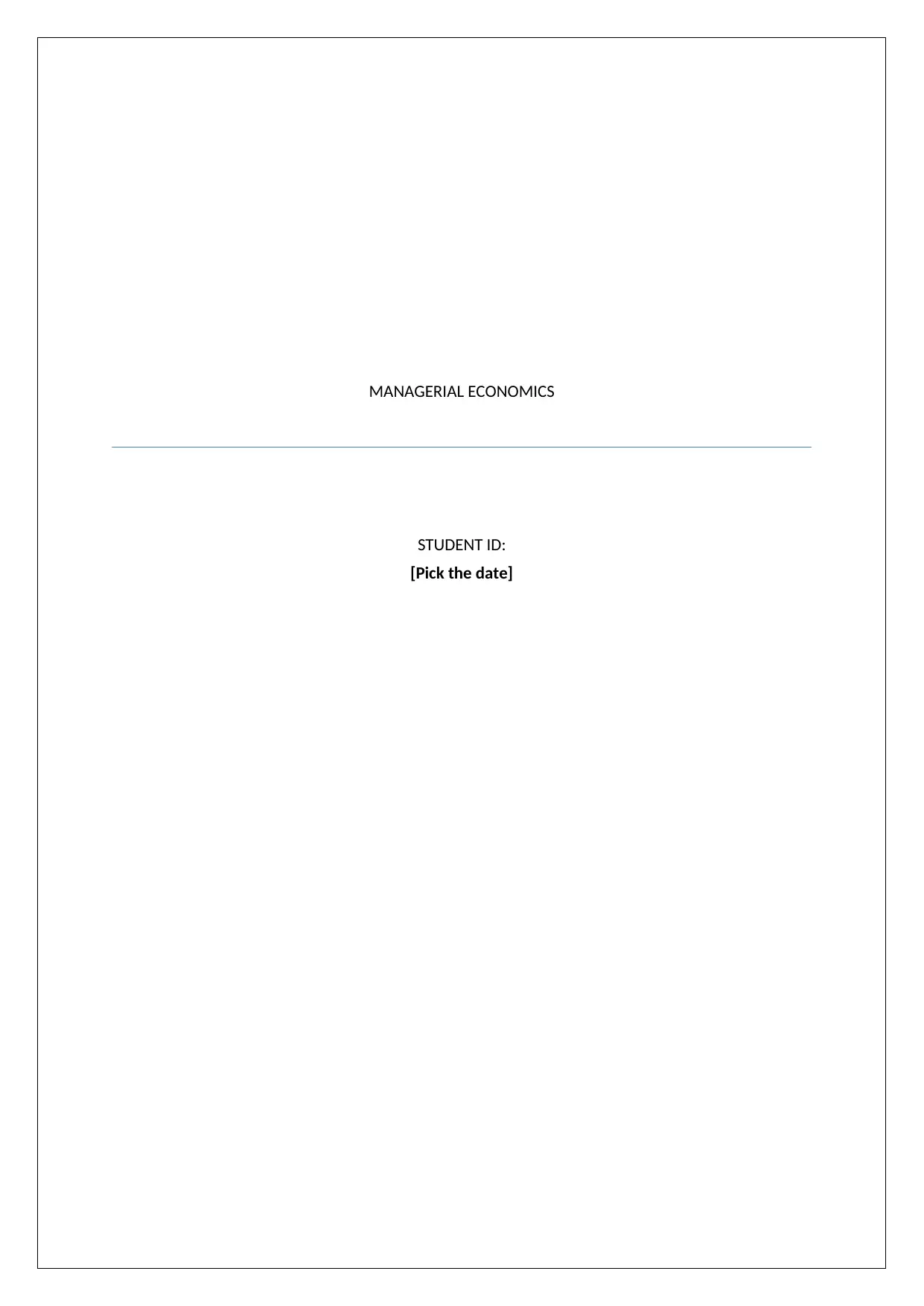
MANAGERIAL ECONOMICS
STUDENT ID:
[Pick the date]
STUDENT ID:
[Pick the date]
Paraphrase This Document
Need a fresh take? Get an instant paraphrase of this document with our AI Paraphraser
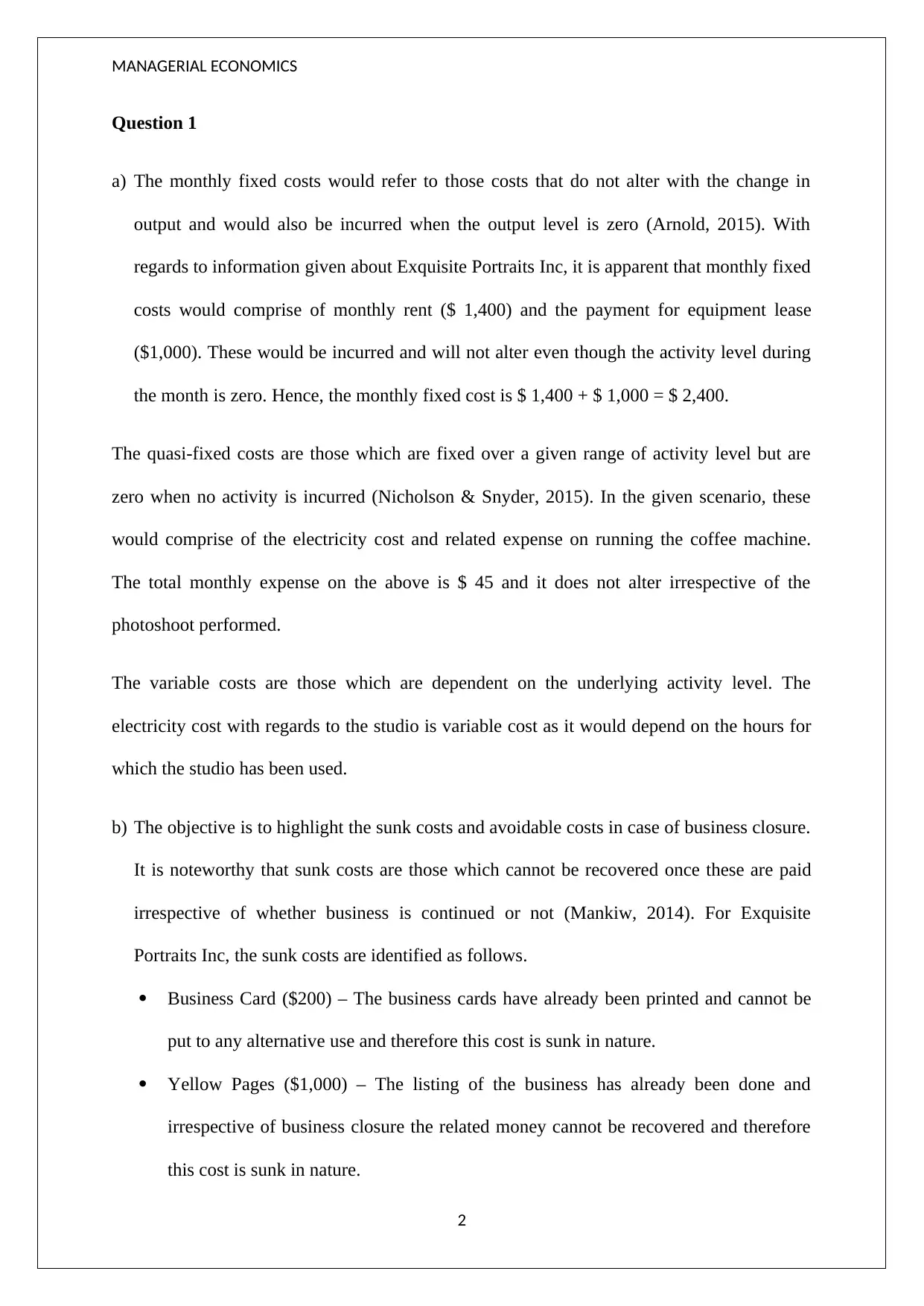
MANAGERIAL ECONOMICS
Question 1
a) The monthly fixed costs would refer to those costs that do not alter with the change in
output and would also be incurred when the output level is zero (Arnold, 2015). With
regards to information given about Exquisite Portraits Inc, it is apparent that monthly fixed
costs would comprise of monthly rent ($ 1,400) and the payment for equipment lease
($1,000). These would be incurred and will not alter even though the activity level during
the month is zero. Hence, the monthly fixed cost is $ 1,400 + $ 1,000 = $ 2,400.
The quasi-fixed costs are those which are fixed over a given range of activity level but are
zero when no activity is incurred (Nicholson & Snyder, 2015). In the given scenario, these
would comprise of the electricity cost and related expense on running the coffee machine.
The total monthly expense on the above is $ 45 and it does not alter irrespective of the
photoshoot performed.
The variable costs are those which are dependent on the underlying activity level. The
electricity cost with regards to the studio is variable cost as it would depend on the hours for
which the studio has been used.
b) The objective is to highlight the sunk costs and avoidable costs in case of business closure.
It is noteworthy that sunk costs are those which cannot be recovered once these are paid
irrespective of whether business is continued or not (Mankiw, 2014). For Exquisite
Portraits Inc, the sunk costs are identified as follows.
Business Card ($200) – The business cards have already been printed and cannot be
put to any alternative use and therefore this cost is sunk in nature.
Yellow Pages ($1,000) – The listing of the business has already been done and
irrespective of business closure the related money cannot be recovered and therefore
this cost is sunk in nature.
2
Question 1
a) The monthly fixed costs would refer to those costs that do not alter with the change in
output and would also be incurred when the output level is zero (Arnold, 2015). With
regards to information given about Exquisite Portraits Inc, it is apparent that monthly fixed
costs would comprise of monthly rent ($ 1,400) and the payment for equipment lease
($1,000). These would be incurred and will not alter even though the activity level during
the month is zero. Hence, the monthly fixed cost is $ 1,400 + $ 1,000 = $ 2,400.
The quasi-fixed costs are those which are fixed over a given range of activity level but are
zero when no activity is incurred (Nicholson & Snyder, 2015). In the given scenario, these
would comprise of the electricity cost and related expense on running the coffee machine.
The total monthly expense on the above is $ 45 and it does not alter irrespective of the
photoshoot performed.
The variable costs are those which are dependent on the underlying activity level. The
electricity cost with regards to the studio is variable cost as it would depend on the hours for
which the studio has been used.
b) The objective is to highlight the sunk costs and avoidable costs in case of business closure.
It is noteworthy that sunk costs are those which cannot be recovered once these are paid
irrespective of whether business is continued or not (Mankiw, 2014). For Exquisite
Portraits Inc, the sunk costs are identified as follows.
Business Card ($200) – The business cards have already been printed and cannot be
put to any alternative use and therefore this cost is sunk in nature.
Yellow Pages ($1,000) – The listing of the business has already been done and
irrespective of business closure the related money cannot be recovered and therefore
this cost is sunk in nature.
2
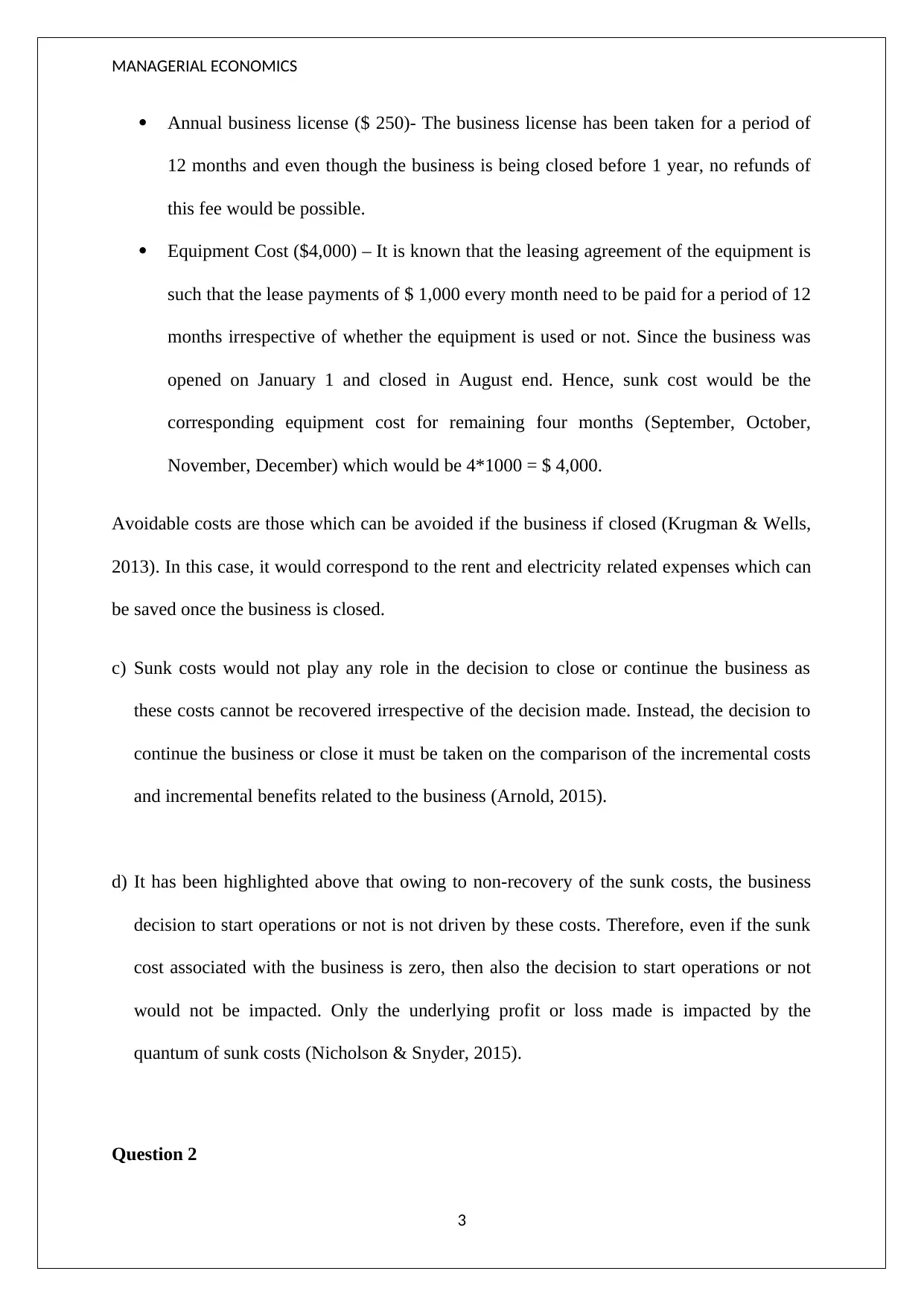
MANAGERIAL ECONOMICS
Annual business license ($ 250)- The business license has been taken for a period of
12 months and even though the business is being closed before 1 year, no refunds of
this fee would be possible.
Equipment Cost ($4,000) – It is known that the leasing agreement of the equipment is
such that the lease payments of $ 1,000 every month need to be paid for a period of 12
months irrespective of whether the equipment is used or not. Since the business was
opened on January 1 and closed in August end. Hence, sunk cost would be the
corresponding equipment cost for remaining four months (September, October,
November, December) which would be 4*1000 = $ 4,000.
Avoidable costs are those which can be avoided if the business if closed (Krugman & Wells,
2013). In this case, it would correspond to the rent and electricity related expenses which can
be saved once the business is closed.
c) Sunk costs would not play any role in the decision to close or continue the business as
these costs cannot be recovered irrespective of the decision made. Instead, the decision to
continue the business or close it must be taken on the comparison of the incremental costs
and incremental benefits related to the business (Arnold, 2015).
d) It has been highlighted above that owing to non-recovery of the sunk costs, the business
decision to start operations or not is not driven by these costs. Therefore, even if the sunk
cost associated with the business is zero, then also the decision to start operations or not
would not be impacted. Only the underlying profit or loss made is impacted by the
quantum of sunk costs (Nicholson & Snyder, 2015).
Question 2
3
Annual business license ($ 250)- The business license has been taken for a period of
12 months and even though the business is being closed before 1 year, no refunds of
this fee would be possible.
Equipment Cost ($4,000) – It is known that the leasing agreement of the equipment is
such that the lease payments of $ 1,000 every month need to be paid for a period of 12
months irrespective of whether the equipment is used or not. Since the business was
opened on January 1 and closed in August end. Hence, sunk cost would be the
corresponding equipment cost for remaining four months (September, October,
November, December) which would be 4*1000 = $ 4,000.
Avoidable costs are those which can be avoided if the business if closed (Krugman & Wells,
2013). In this case, it would correspond to the rent and electricity related expenses which can
be saved once the business is closed.
c) Sunk costs would not play any role in the decision to close or continue the business as
these costs cannot be recovered irrespective of the decision made. Instead, the decision to
continue the business or close it must be taken on the comparison of the incremental costs
and incremental benefits related to the business (Arnold, 2015).
d) It has been highlighted above that owing to non-recovery of the sunk costs, the business
decision to start operations or not is not driven by these costs. Therefore, even if the sunk
cost associated with the business is zero, then also the decision to start operations or not
would not be impacted. Only the underlying profit or loss made is impacted by the
quantum of sunk costs (Nicholson & Snyder, 2015).
Question 2
3
⊘ This is a preview!⊘
Do you want full access?
Subscribe today to unlock all pages.

Trusted by 1+ million students worldwide
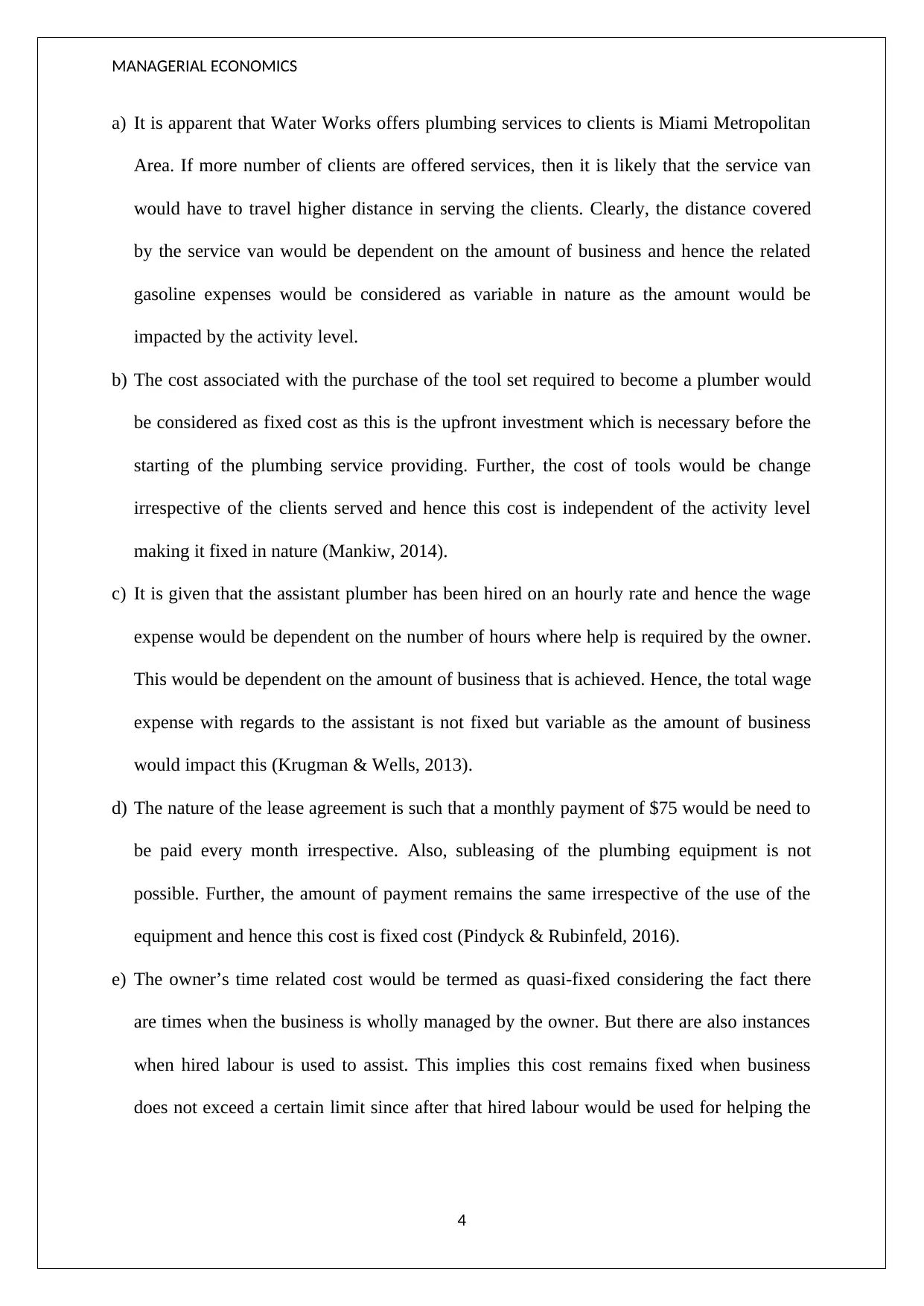
MANAGERIAL ECONOMICS
a) It is apparent that Water Works offers plumbing services to clients is Miami Metropolitan
Area. If more number of clients are offered services, then it is likely that the service van
would have to travel higher distance in serving the clients. Clearly, the distance covered
by the service van would be dependent on the amount of business and hence the related
gasoline expenses would be considered as variable in nature as the amount would be
impacted by the activity level.
b) The cost associated with the purchase of the tool set required to become a plumber would
be considered as fixed cost as this is the upfront investment which is necessary before the
starting of the plumbing service providing. Further, the cost of tools would be change
irrespective of the clients served and hence this cost is independent of the activity level
making it fixed in nature (Mankiw, 2014).
c) It is given that the assistant plumber has been hired on an hourly rate and hence the wage
expense would be dependent on the number of hours where help is required by the owner.
This would be dependent on the amount of business that is achieved. Hence, the total wage
expense with regards to the assistant is not fixed but variable as the amount of business
would impact this (Krugman & Wells, 2013).
d) The nature of the lease agreement is such that a monthly payment of $75 would be need to
be paid every month irrespective. Also, subleasing of the plumbing equipment is not
possible. Further, the amount of payment remains the same irrespective of the use of the
equipment and hence this cost is fixed cost (Pindyck & Rubinfeld, 2016).
e) The owner’s time related cost would be termed as quasi-fixed considering the fact there
are times when the business is wholly managed by the owner. But there are also instances
when hired labour is used to assist. This implies this cost remains fixed when business
does not exceed a certain limit since after that hired labour would be used for helping the
4
a) It is apparent that Water Works offers plumbing services to clients is Miami Metropolitan
Area. If more number of clients are offered services, then it is likely that the service van
would have to travel higher distance in serving the clients. Clearly, the distance covered
by the service van would be dependent on the amount of business and hence the related
gasoline expenses would be considered as variable in nature as the amount would be
impacted by the activity level.
b) The cost associated with the purchase of the tool set required to become a plumber would
be considered as fixed cost as this is the upfront investment which is necessary before the
starting of the plumbing service providing. Further, the cost of tools would be change
irrespective of the clients served and hence this cost is independent of the activity level
making it fixed in nature (Mankiw, 2014).
c) It is given that the assistant plumber has been hired on an hourly rate and hence the wage
expense would be dependent on the number of hours where help is required by the owner.
This would be dependent on the amount of business that is achieved. Hence, the total wage
expense with regards to the assistant is not fixed but variable as the amount of business
would impact this (Krugman & Wells, 2013).
d) The nature of the lease agreement is such that a monthly payment of $75 would be need to
be paid every month irrespective. Also, subleasing of the plumbing equipment is not
possible. Further, the amount of payment remains the same irrespective of the use of the
equipment and hence this cost is fixed cost (Pindyck & Rubinfeld, 2016).
e) The owner’s time related cost would be termed as quasi-fixed considering the fact there
are times when the business is wholly managed by the owner. But there are also instances
when hired labour is used to assist. This implies this cost remains fixed when business
does not exceed a certain limit since after that hired labour would be used for helping the
4
Paraphrase This Document
Need a fresh take? Get an instant paraphrase of this document with our AI Paraphraser
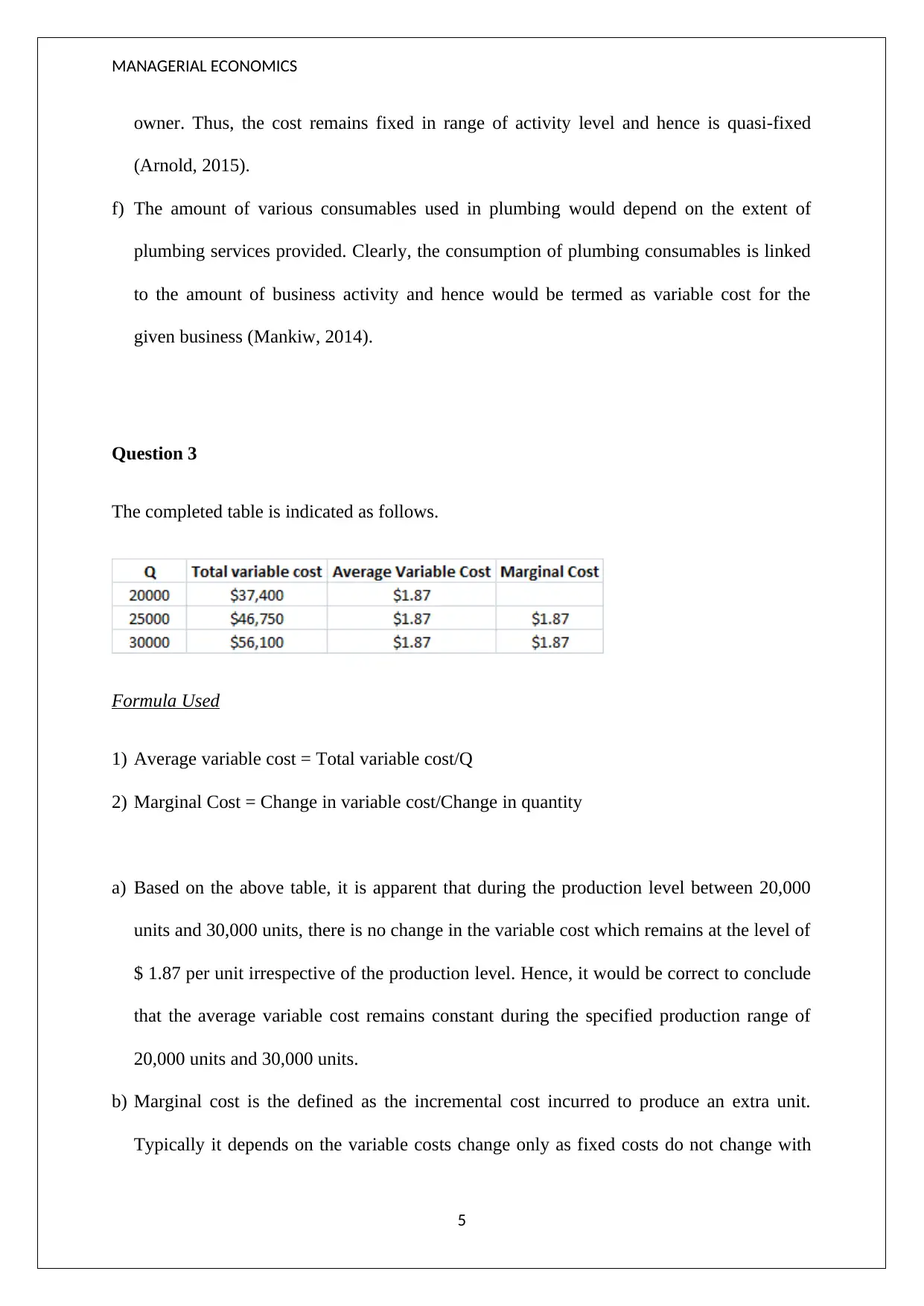
MANAGERIAL ECONOMICS
owner. Thus, the cost remains fixed in range of activity level and hence is quasi-fixed
(Arnold, 2015).
f) The amount of various consumables used in plumbing would depend on the extent of
plumbing services provided. Clearly, the consumption of plumbing consumables is linked
to the amount of business activity and hence would be termed as variable cost for the
given business (Mankiw, 2014).
Question 3
The completed table is indicated as follows.
Formula Used
1) Average variable cost = Total variable cost/Q
2) Marginal Cost = Change in variable cost/Change in quantity
a) Based on the above table, it is apparent that during the production level between 20,000
units and 30,000 units, there is no change in the variable cost which remains at the level of
$ 1.87 per unit irrespective of the production level. Hence, it would be correct to conclude
that the average variable cost remains constant during the specified production range of
20,000 units and 30,000 units.
b) Marginal cost is the defined as the incremental cost incurred to produce an extra unit.
Typically it depends on the variable costs change only as fixed costs do not change with
5
owner. Thus, the cost remains fixed in range of activity level and hence is quasi-fixed
(Arnold, 2015).
f) The amount of various consumables used in plumbing would depend on the extent of
plumbing services provided. Clearly, the consumption of plumbing consumables is linked
to the amount of business activity and hence would be termed as variable cost for the
given business (Mankiw, 2014).
Question 3
The completed table is indicated as follows.
Formula Used
1) Average variable cost = Total variable cost/Q
2) Marginal Cost = Change in variable cost/Change in quantity
a) Based on the above table, it is apparent that during the production level between 20,000
units and 30,000 units, there is no change in the variable cost which remains at the level of
$ 1.87 per unit irrespective of the production level. Hence, it would be correct to conclude
that the average variable cost remains constant during the specified production range of
20,000 units and 30,000 units.
b) Marginal cost is the defined as the incremental cost incurred to produce an extra unit.
Typically it depends on the variable costs change only as fixed costs do not change with
5
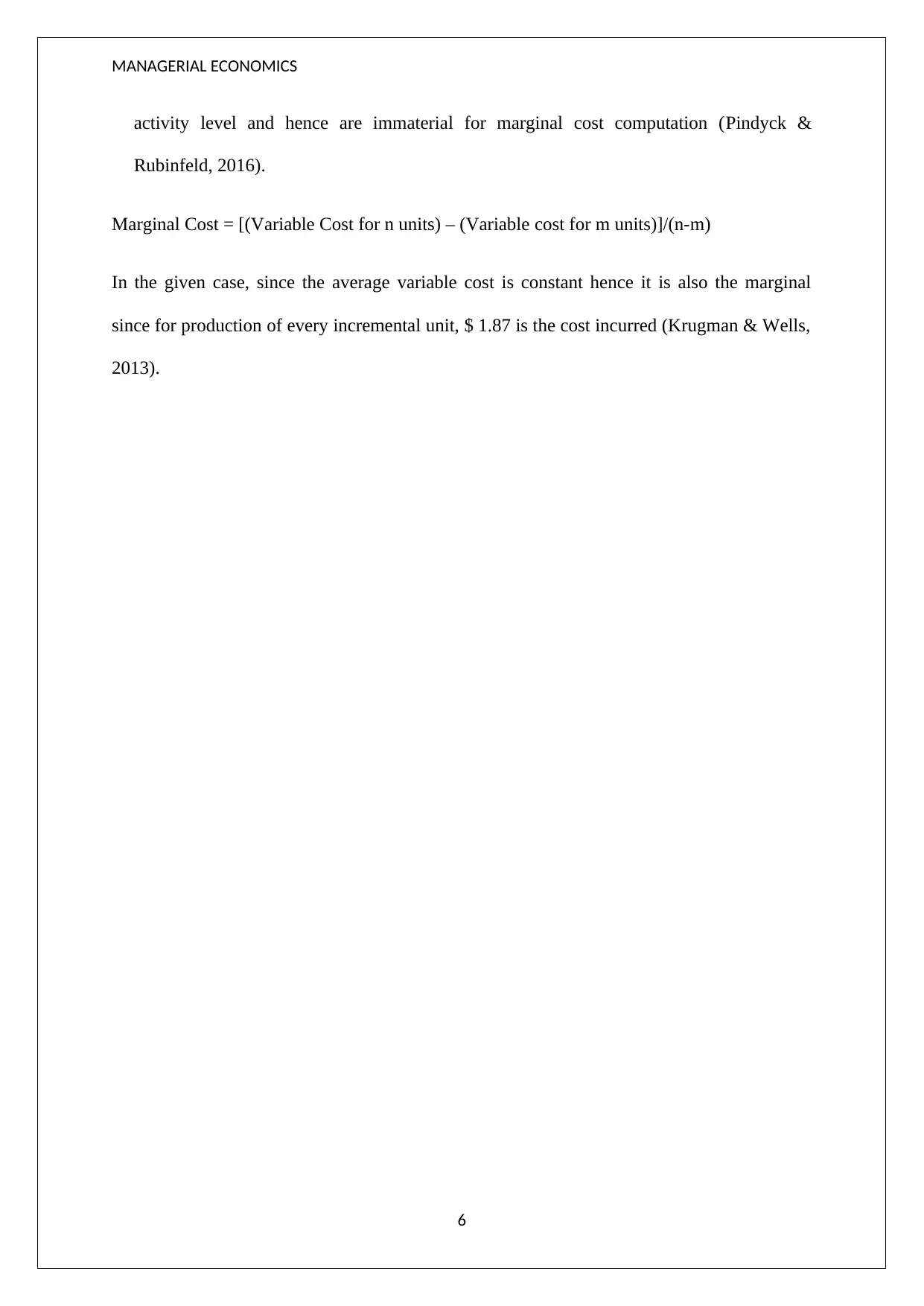
MANAGERIAL ECONOMICS
activity level and hence are immaterial for marginal cost computation (Pindyck &
Rubinfeld, 2016).
Marginal Cost = [(Variable Cost for n units) – (Variable cost for m units)]/(n-m)
In the given case, since the average variable cost is constant hence it is also the marginal
since for production of every incremental unit, $ 1.87 is the cost incurred (Krugman & Wells,
2013).
6
activity level and hence are immaterial for marginal cost computation (Pindyck &
Rubinfeld, 2016).
Marginal Cost = [(Variable Cost for n units) – (Variable cost for m units)]/(n-m)
In the given case, since the average variable cost is constant hence it is also the marginal
since for production of every incremental unit, $ 1.87 is the cost incurred (Krugman & Wells,
2013).
6
⊘ This is a preview!⊘
Do you want full access?
Subscribe today to unlock all pages.

Trusted by 1+ million students worldwide

MANAGERIAL ECONOMICS
References
Arnold, A.R. (2015). Microeconomics (9thed.). New York, NY: Cengage Learning.
Krugman, P. & Wells, R. (2013).Microeconomics (2nded.). London: Worth Publishers.
Mankiw, G. (2014) Microeconomics (6thed.). London: Worth Publishers.
Nicholson, W. & Snyder, C. (2015).Fundamentals of Microeconomics (11thed.). New York,
NY: Cengage Learning.
Pindyck, R. & Rubinfeld, D. (2016).Microeconomics (5thed.). London:Prentice-Hall
Publications
7
References
Arnold, A.R. (2015). Microeconomics (9thed.). New York, NY: Cengage Learning.
Krugman, P. & Wells, R. (2013).Microeconomics (2nded.). London: Worth Publishers.
Mankiw, G. (2014) Microeconomics (6thed.). London: Worth Publishers.
Nicholson, W. & Snyder, C. (2015).Fundamentals of Microeconomics (11thed.). New York,
NY: Cengage Learning.
Pindyck, R. & Rubinfeld, D. (2016).Microeconomics (5thed.). London:Prentice-Hall
Publications
7
1 out of 7
Your All-in-One AI-Powered Toolkit for Academic Success.
+13062052269
info@desklib.com
Available 24*7 on WhatsApp / Email
![[object Object]](/_next/static/media/star-bottom.7253800d.svg)
Unlock your academic potential
Copyright © 2020–2025 A2Z Services. All Rights Reserved. Developed and managed by ZUCOL.